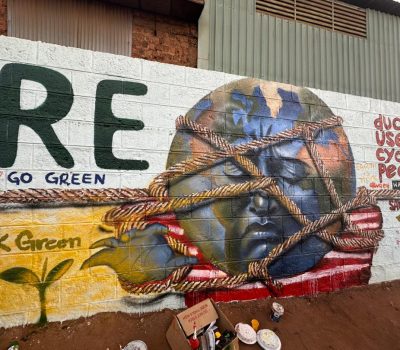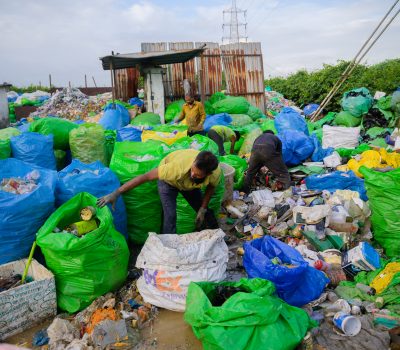Circular Opportunities for E-waste repair and reuse of electrical and electronic equipment in South Africa
News, Thought Pieces,
Author: Jessica Stickland
Published: 16 February 2024
by Angela Ludek, WasteAid’s Project Officer – Informal Sector Engagement, South Africa
About 360,000 tonnes of e-waste is generated each year across South Africa, with the province of Gauteng responsible for approximately 55% of this total. Globally e-waste is growing at a rapid rate with a lot of e-waste shipped to Africa and Asia for recycling. Around 50 million tons is generated annually. This is equivalent to throwing out 432 laptops every minute.
According to the EPR Waste Association of South Africa (eWASA), South Africans produce about 6.2kg of electronic waste per person per year. Around 12% of this is formally recycled and the majority of the remainder makes its way straight to landfill, where it dissolves gradually into the gross sludge that permeates at the landfill, known as leaching. This is hazardous to both human and environmental health as e-waste contains extremely toxic chemicals such as lead, arsenic, and mercury, flame retardants and certain phthalates. With the reality of strained structural resources in South Africa, a lot of e-waste is simply burned in communities, which means that people living there, including children, have high exposure to the toxicity released.
In between there is a missing middle: the informal repairers who are an important part of South Africa’s reuse, repair and recycling economy. They work in the heart of communities as they interface with the informal waste pickers who recover valuable resources and divert these resources from landfill towards reuse and recycling. Repairers trade with waste collectors for e-waste components to repair electrical and electronic equipment for a growing customer base of those living in townships who find it cheaper to repair than buy new appliances, for example. By investing in the community repair and reuse ecosystem, the potential of scaling up the recovery of e-waste is amplified and the livelihood opportunities of repairers within the informal economy is increased.
Building on WasteAid’s experience of delivering professional training and investing seed funding in ‘wastepreneurs’ in South Africa to scale up waste recovery into the materials value chain, WasteAid has extended its programme to e-waste.
Supported by the Dixon Foundation, a UK charity that nurtures positive change for the planet’s future, WasteAid has developed a programme that facilitates and supports e-waste repair and reuse models, by investing in repair micro-businesses within Diepsloot, a densely populated township in Gauteng. This interception of e-waste into appliance repair models keeps products and materials in use, and is part of a circular approach that is paving the way for a more sustainable future.
The E-Waste Repair and Reuse Programme transferred knowledge on repairing electrical appliances through the business incubation training, with a practical application on electrical circuitry and appliance repair during the programme.
The e-waste training programme curriculum has been designed to include an inclusive overview of the business of e-waste repair with an extensive overview of circular economy principles, as well as the global and local implications of e-waste.
Ten active repairers took part in and completed the programme. Training took place at the Wot-If? Trust e-Hub in Diepsloot township in Johannesburg, South Africa, which was central for all participating repairers to access. It was delivered by four specialised local trainers.
The training programme primarily focused on electrical repair related to small domestic appliances which included larger white goods.
During the practical sessions, a range of domestic appliances were donated for fixing from WasteAid’s network of waste and environmental practitioners. All of which were all fixed during class and included: kettles, urns, slow-cooker, irons, microwaves, fans, monitors, a washing machine and a deep freezer.
Some fixed items were donated back to the community organisations they came from, and some network members who contributed equipment for fixing, donated an amount of money to the repairers to share.
All participants had indicated at the start of the project that they lacked access to specialised tools as they were costly to invest in. To entrench business growth by building capacity, each participating repairer received capital investment in the form of tools needed to ensure the effective turnaround time of repairing items.
The needs analysis at the start of the programme indicated challenges they each face in building trusted relationships with their customers that will lead to an increase in returning customers, and in turn an increase in income.
After the programme, the upskilled repairers said that as micro-businesses they now feel that they will build stronger trusted relationships with their customers as they have solid knowledge of the proper repair standards and safety surrounding the repair of electrical appliances and circuitry.
All ten participating repairers concluded that the training was very useful to them and they were proud to showcase their certification of the programme to their customers and community. They all indicated that the business and financial knowledge and digital marketing aspects added huge value to the running of their businesses.
Through this programme, it became clear to participants that there is further value for business growth in repair by amplifying the inclusion of components from e-waste generated in the community into their repair models.
This has resulted in the repairers engaging with community members, especially the wastepreneurs (reclaimers that went through WasteAid’s Wastepreneur Challenge programmes) to acquire components of electrical and electronic waste that they collect. Repairers will buy these components from them instead of new components for repair and so creating an ecosystem that allows for awareness and exchange.
Repairer David Chiporore commented; “I used to throw away common parts, now I can use them and get money”.
The feedback indicated that the practical training of the electrical aspects increased their confidence in their skill set to repair and that they appreciated the e-waste overview and breakdown of electronic equipment to understand the value of the extracted minerals, as well as the overall perspective of utilising e-waste components for repair.
The E-Waste Repair and Reuse Programme demonstrated that this approach is scalable, and WasteAid is exploring how to replicate this programme in the province and elsewhere in South Africa.
These programmes focused on e-waste recovery will amplify the usage of discarded e-waste components in communities to accelerate keeping e-waste in the local ecosystem through repair and reuse models.










